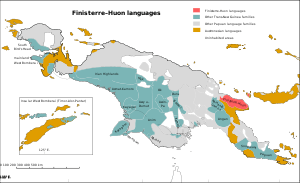Finisterre–Huon languages
The Finisterre–Huon languages comprise the largest family within the Trans–New Guinea languages (TNG) in the classification of Malcolm Ross. They were part of the original TNG proposal, and William A. Foley considers their TNG identity to be established. The languages share a small closed class of verbs taking pronominal object prefixes some of which are cognate (Suter 2012), strong morphological evidence that they are related.
| Finisterre–Huon | |
|---|---|
| Geographic distribution | Finisterre Range and Huon Peninsula, Morobe Province, Papua New Guinea |
| Linguistic classification | Trans–New Guinea
|
| Subdivisions | |
| Glottolog | fini1244[1] |
 Map: The Finisterre–Huon languages of New Guinea
The Finisterre–Huon languages
Other Trans–New Guinea languages
Other Papuan languages
Austronesian languages
Uninhabited | |
History of classification
Huon and Finisterre, and then the connection between them, were identified by Kenneth McElhanon (1967, 1970). When McElhanon compared notes with his colleague Clemens Voorhoeve, who was working on the languages of southern Irian Jaya, they developed the concept of Trans–New Guinea. Apart from the evidence which unites them, the Finisterre and Huon families are clearly valid language families in their own right, each consisting of several fairly-well defined branches. (See Finisterre languages and Huon languages.)
Pronouns
Ross (2005) reconstructs the pronouns as follows:
sg du pl 1 *na *na-t, *ni-t *na-n, *n-in 2 *ga *ja-ł, *ji-ł, *gi-ł *ja-n, *ji-n, *gi-n 3 *[y]a, *wa, *i *ya-ł, *i-ł *ya-n, *i-n
These are not all coherent: 3sg *ya and *i are found in Huon, for example, while 3sg *wa is found in Finisterre. In other cases, however, the multiple forms are found in both branches.
Evolution
Finisterre-Huon reflexes of proto-Trans-New Guinea (pTNG) etyma are:[2]
- bɔruŋ ‘flame’ < *mbalaŋ ‘flame’
- butoŋ ‘fingernail’ < *mb(i,u)t(i,u)C
- bekɔ ‘orphan’ < *mbVŋga(-masi)
- masiŋ ‘widow’ < *masi
- sambɔŋ ‘sky’ < *sambV ‘cloud’
- tofeʔ ‘saliva’ < *si(mb,p)atV
- lo- ‘take’ < *(nd,t)a-
- munduŋ ‘inner yolk of egg’ < *mundun ‘internal organs’
- go ‘2sg’ < *ŋga
- hɔmo- ‘die’ < *kumV-
- bɔriʔ ‘glitter, flash of lightning’ < *(m,mb)elak ‘light, lightning’
- mi ‘not’ < *ma- ‘not’
- maŋu(zo) ‘to vomit’ < *mV(k,ŋ)V t(e,i)-
- ame(ʔ) ‘breast’ < *amu
- tsimin(uŋ) ‘stiff coarse hair’ < *[nd,s]umu[n,t]V ‘hair’
- imeŋ ‘louse’ < *iman ‘louse’
- no ‘1sg’ < *na ‘1sg’
- nɔ- ‘eat’ < *na-
- balam ‘flame’ < *mbalaŋ
- (ni)bilim ‘tongue’ < *mbilaŋ
- kɔlɔp ‘fire’ < *kend(o,u)p
- kɔlip ‘long’ < *kuta(mb,p)(a,u)
- irak ‘new’ < *kVtak
- sak ‘sand’ < *sa(ŋg,k)asin
- somot ‘hair’ < *(s,nd)umu(n,t)[V]
- madu ‘orphan’ < *masi
- si- ‘burn’ < *nj(a,e,i)- ‘burn’
- ga ‘2sg’ < *ŋga
- kaku- ‘carry on shoulder’ < *kakV-
- kɔu ‘ashes’ < *kambu ‘ashes’
- belek ‘lightning’ < *(m,mb)elak
- ibi ‘name’ < *imbi
- mete ‘forehead’ < *me(n,t)e ‘head’
- man- ‘live, dwell’ < *mVn[a]-
- imen ‘louse’ < *iman ‘louse’
- (n)am ‘breast, milk’ < *amu ‘breast’
Footnotes
- Hammarström, Harald; Forkel, Robert; Haspelmath, Martin, eds. (2017). "Finisterre–Huon". Glottolog 3.0. Jena, Germany: Max Planck Institute for the Science of Human History.
- Pawley, Andrew; Hammarström, Harald (2018). "The Trans New Guinea family". In Palmer, Bill (ed.). The Languages and Linguistics of the New Guinea Area: A Comprehensive Guide. The World of Linguistics. 4. Berlin: De Gruyter Mouton. pp. 21–196. ISBN 978-3-11-028642-7.
References
- Ross, Malcolm (2005). "Pronouns as a preliminary diagnostic for grouping Papuan languages". In Andrew Pawley; Robert Attenborough; Robin Hide; Jack Golson (eds.). Papuan pasts: cultural, linguistic and biological histories of Papuan-speaking peoples. Canberra: Pacific Linguistics. pp. 15–66. ISBN 0858835622. OCLC 67292782.
- Suter, Edgar (2012). Verbs with pronominal object prefixes in Finisterre–Huon languages. In: Harald Hammarström and Wilco van den Heuvel (eds.). History, contact and classification of Papuan languages. [Special Issue 2012 of Language and Linguistics in Melanesia]. 23-58. Port Moresby: Linguistic Society of Papua New Guinea.
Further reading
- Ross, Malcolm. 2014. Proto-Finisterre-Huon. TransNewGuinea.org.